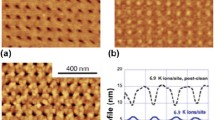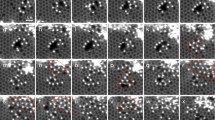Abstract
Precise spatial ordering of quantum dots (QDs) may enable predictable quantum states due to direct exchange interactions of confined carriers. The realization of predictable quantum states may lead to unique functionalities such as spin cluster qubits and spintronic band gap systems. To define exemplary quantum architectures, one must develop control over QD size and spatial arrangement on the sub-35-nm length scale. We use fine-probe electron beam irradiation to locally decompose ambient hydrocarbons onto a bare Si(001) surface. These carbonaceous patterns are annealed in ultrahigh vacuum (UHV), forming ordered arrays of nanoscale SiC QDs. We have achieved sub-10-nm diameter epitaxially oriented 3C-SiC nanodots with interdot spacings down to 22.5 nm. We investigate the templated feature evolution during UHV annealing and subsequent Ge epitaxial overgrowth to identify key mechanisms that must be controlled to preserve pattern fidelity and reduce broadening of the nanodot distribution.







Similar content being viewed by others
References
F. Meier, J. Levy, and D. Loss: Quantum computing with spin cluster qubits. Phys. Rev. Lett. 90, 047901 (2003).
F. Meier, J. Levy, and D. Loss: Quantum computing with antiferromagnetic spin clusters. Phys. Rev. B 68, 134417 (2003).
C.E. Pryor, M.E. Flatté, and J. Levy: Electrical manipulation of an electronic two-state system in Ge quantum dots. Appl. Phys. Lett. 95, 232103 (2009).
O. Guise, H. Marbach, J. Levy, J. Ahner, and J.T. Yates Jr.: Electron-beam-induced deposition of carbon films on Si(1 0 0) using chemisorbed ethylene as a precursor molecule. Surf. Sci. 571, 128–138 (2004).
O. Guise, J. Ahner, J. Yates, and J. Levy: Formation and thermal stability of sub-10-nm carbon templates on Si(100). Appl. Phys. Lett. 85, 2352–2354 (2004).
O. Guise: Patterning of sub-10-nm Ge islands on Si(100) by directed self-assembly. Appl. Phys. Lett. 87, 171902 (2005).
C.W. Petz, D. Yang, J. Levy, and J.A. Floro: Structure of Si-capped Ge/SiC/Si (001) epitaxial nanodots: Implications for quantum dot patterning. Appl. Phys. Lett. 100, 141603 (2012).
G. Katsaros: Investigating the lateral motion of SiGe islands by selective chemical etching. Surf. Sci. 600, 2608–2613 (2006).
T. Merdzhanova, A. Rastelli, M. Stoffel, S. Kiravittaya, and O.G. Schmidt: Island motion triggered by the growth of strain-relaxed SiGe/Si(0 0 1) islands. J. Crystal Growth 301–302, 319–323 (2007).
H.U. Danzebrink, L. Koenders, G. Wilkening, A. Yacoot, and H. Kunzmann: Advances in scanning force microscopy for dimensional metrology. CIRP Ann. Manuf. Sci. Technol. 55, 841–878 (2006).
C.K. Chung and B.H. Wu: Effect of substrate temperature on the in-situ formation of crystalline SiC nanostructured film using ultra-high-vacuum ion beam sputtering. J. Nanosci. Nanotechnol. 10, 4679–4683 (2010).
C.K. Chung and B.H. Wu: Thermally induced formation of SiC nanoparticles from Si/C/Si multilayers deposited by ultra-high-vacuum ion beam sputtering. Nanotechnology 17, 3129–3133 (2006).
M. Krishnamurthy, J.S. Drucker, and A. Challa: Epitaxial growth and characterization of Ge1−xCx alloys on Si(100). J. Appl. Phys. 78, 7070 (1995).
C.J. Palmstrom: Epitaxy of dissimilar materials. Annu. Rev. Mater. Sci. 25, 389–415 (1995).
A. Trampert: Heteroepitaxy of dissimilar materials: Effect of interface structure on strain and defect formation. Physica E 13, 1119–1125 (2002).
J.A. Floro, J.R. Michael, L.N. Brewer, and J.W.P Hsu: Preferred heteroepitaxial orientations of ZnO nanorods on Ag. J. Mater. Res. 25, 1352–1361 (2010).
D. Yang, C.W. Petz, and J.A. Floro, and J. Levy: Unpublished.
Acknowledgments
Support from the U.S. Department of Energy Office of Basic Energy Sciences is gratefully acknowledged under Grant No. DE-FG02-07ER46421.
Author information
Authors and Affiliations
Corresponding author
Rights and permissions
About this article
Cite this article
Petz, C.W., Yang, D., Levy, J. et al. Formation and thermal stability of 2D ordered SiC/Si(001) nanodots. Journal of Materials Research 28, 261–267 (2013). https://doi.org/10.1557/jmr.2012.406
Received:
Accepted:
Published:
Issue Date:
DOI: https://doi.org/10.1557/jmr.2012.406




